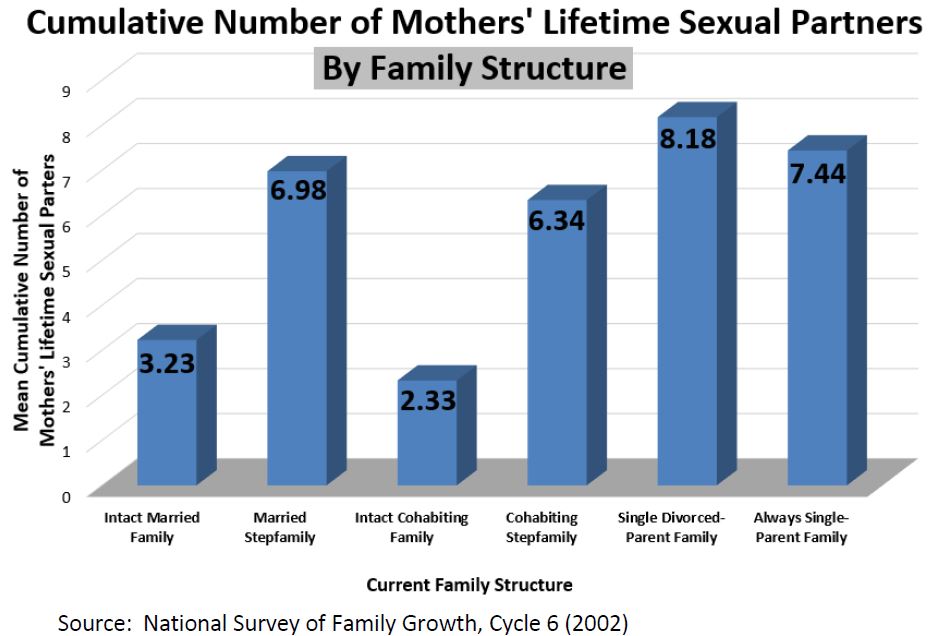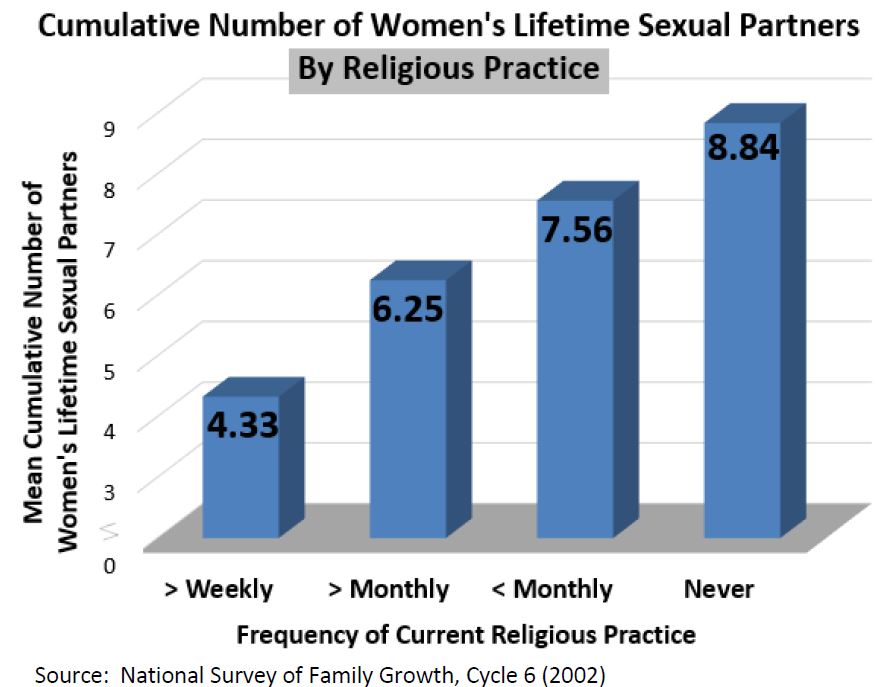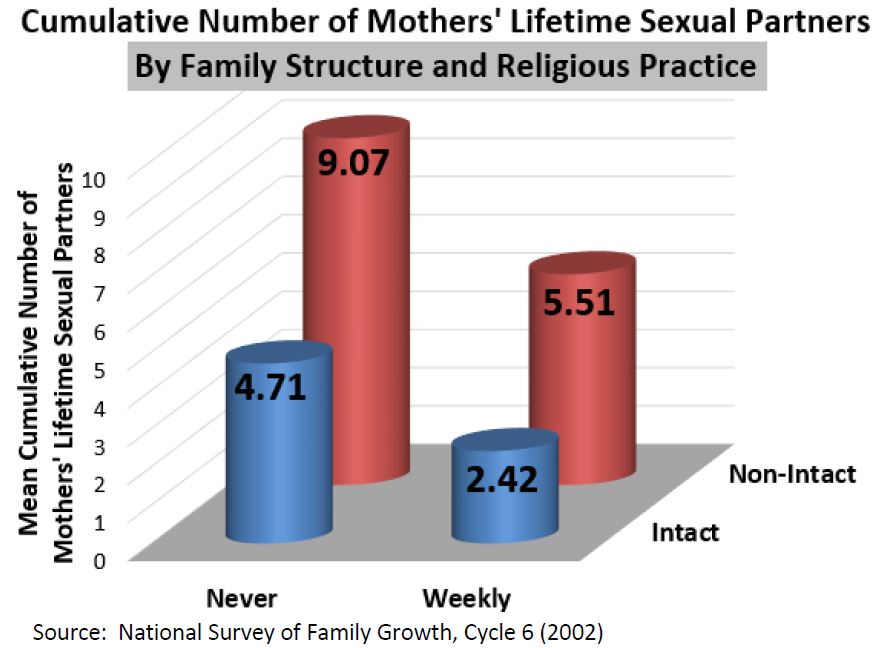Click Here to download “Cumulative Number of Women’s Lifetime Sexual Partners by Family Structure and Religious Practice”
Cumulative Number of Women’s Lifetime Sexual Partners by Family Structure and Religious Practice
Family Structure: According to the National Survey of Family Growth, Cycle 6 (2002),
[1] mothers aged 35-44 in intact cohabiting relationships had, on average, 2.33 lifetime sexual partners, followed by mothers in always-intact marriages (3.23), those in cohabiting stepfamilies (6.34), those in married stepfamilies (6.98), those who had always been single (7.44), and those who were divorced (8.18).
 Religious Practice:
Religious Practice: Based on the National Survey of Family Growth (2002),
[2] women aged 35-44 who worshiped at least weekly had, on average, 4.33 lifetime sexual partners, followed by those who worshiped between one and three times a month (6.25), those who attended religious services less than once a month (7.56), and those who never attended religious services (8.84).
 Family Structure and Religious Practice Combined:
Family Structure and Religious Practice Combined: Mothers, aged 35-44, in always-intact marriages who worshiped at least weekly were more likely to have had fewer lifetime sexual partners than mothers in all other family structure and worship combinations. According to the National Survey of Family Growth (NSFG), mothers in always-intact marriages who attended religious services at least weekly had, on average, 2.42 lifetime sexual partners, followed by mothers in always-intact marriages who never worshiped (4.71), those in other family structures who worshiped at least weekly (5.51), and those in other family structures who never worshiped (9.07).
 Related Insights from Other Studies:
Related Insights from Other Studies: Several other studies corroborate the direction of these findings. Jay Teachman of Western Washington University reported that women who engaged in multiple premarital intimate relationships increased their risk of divorce.
[3]
Jason Weeden of Arizona State University and colleagues also found that religious attendance correlates to a marriage-centered sexual and reproductive strategy.
[4]
Wade C. Rowatt of Baylor University and David P. Schmitt of Bradley University reported that those who view religion as an end, rather than as a means to another personal or social end, show less interest in having multiple sex partners.
[5]
As the evidence indicates, mothers in always-intact marriages who worship at least weekly have fewer sexual partners than those in most other family structures who worship less frequently.
[1] These charts draw on data collected by the National Survey of Family Growth, Cycle 6 (2002). The sample consists of women between the ages of 35 and 44 and numbers 2,479.
[2] Whereas the present family structure sample data and combined religious attendance/family structure sample data describe only the population of mothers between the ages of 35 and 44, the religious attendance data describe the population of
all women between the ages of 35 and 44. We realize these charts would have more value if all three charts drew from the same population set, but the difference was only noted after the data was in.
[3] Jay Teachman, “Premarital Sex, Premarital Cohabitation, and the Risk of Subsequent Marital Dissolution among Women,”
Journal of Marriage and Family 65 (2003): 444-55.
[4] Jason Weeden, Adam B. Cohen, and Douglas T. Kenrick, “Religious Attendance as Reproductive Support,”
Evolution and Human Behavior 29 (2008): 327-34.
[5] Wade C. Rowatt and David P. Schmitt, “Associations between Religious Orientation and Varieties of Sexual Experience,”
Journal for the Scientific Study of Religion 42 (2003): 455-65.]]>
 Religious Practice: Based on the National Survey of Family Growth (2002),[2] women aged 35-44 who worshiped at least weekly had, on average, 4.33 lifetime sexual partners, followed by those who worshiped between one and three times a month (6.25), those who attended religious services less than once a month (7.56), and those who never attended religious services (8.84).
Religious Practice: Based on the National Survey of Family Growth (2002),[2] women aged 35-44 who worshiped at least weekly had, on average, 4.33 lifetime sexual partners, followed by those who worshiped between one and three times a month (6.25), those who attended religious services less than once a month (7.56), and those who never attended religious services (8.84).
 Family Structure and Religious Practice Combined: Mothers, aged 35-44, in always-intact marriages who worshiped at least weekly were more likely to have had fewer lifetime sexual partners than mothers in all other family structure and worship combinations. According to the National Survey of Family Growth (NSFG), mothers in always-intact marriages who attended religious services at least weekly had, on average, 2.42 lifetime sexual partners, followed by mothers in always-intact marriages who never worshiped (4.71), those in other family structures who worshiped at least weekly (5.51), and those in other family structures who never worshiped (9.07).
Family Structure and Religious Practice Combined: Mothers, aged 35-44, in always-intact marriages who worshiped at least weekly were more likely to have had fewer lifetime sexual partners than mothers in all other family structure and worship combinations. According to the National Survey of Family Growth (NSFG), mothers in always-intact marriages who attended religious services at least weekly had, on average, 2.42 lifetime sexual partners, followed by mothers in always-intact marriages who never worshiped (4.71), those in other family structures who worshiped at least weekly (5.51), and those in other family structures who never worshiped (9.07).
 Related Insights from Other Studies: Several other studies corroborate the direction of these findings. Jay Teachman of Western Washington University reported that women who engaged in multiple premarital intimate relationships increased their risk of divorce.[3]
Jason Weeden of Arizona State University and colleagues also found that religious attendance correlates to a marriage-centered sexual and reproductive strategy.[4]
Wade C. Rowatt of Baylor University and David P. Schmitt of Bradley University reported that those who view religion as an end, rather than as a means to another personal or social end, show less interest in having multiple sex partners.[5]
As the evidence indicates, mothers in always-intact marriages who worship at least weekly have fewer sexual partners than those in most other family structures who worship less frequently.
[1] These charts draw on data collected by the National Survey of Family Growth, Cycle 6 (2002). The sample consists of women between the ages of 35 and 44 and numbers 2,479.
[2] Whereas the present family structure sample data and combined religious attendance/family structure sample data describe only the population of mothers between the ages of 35 and 44, the religious attendance data describe the population of all women between the ages of 35 and 44. We realize these charts would have more value if all three charts drew from the same population set, but the difference was only noted after the data was in.
[3] Jay Teachman, “Premarital Sex, Premarital Cohabitation, and the Risk of Subsequent Marital Dissolution among Women,” Journal of Marriage and Family 65 (2003): 444-55.
[4] Jason Weeden, Adam B. Cohen, and Douglas T. Kenrick, “Religious Attendance as Reproductive Support,” Evolution and Human Behavior 29 (2008): 327-34.
[5] Wade C. Rowatt and David P. Schmitt, “Associations between Religious Orientation and Varieties of Sexual Experience,” Journal for the Scientific Study of Religion 42 (2003): 455-65.]]>
Related Insights from Other Studies: Several other studies corroborate the direction of these findings. Jay Teachman of Western Washington University reported that women who engaged in multiple premarital intimate relationships increased their risk of divorce.[3]
Jason Weeden of Arizona State University and colleagues also found that religious attendance correlates to a marriage-centered sexual and reproductive strategy.[4]
Wade C. Rowatt of Baylor University and David P. Schmitt of Bradley University reported that those who view religion as an end, rather than as a means to another personal or social end, show less interest in having multiple sex partners.[5]
As the evidence indicates, mothers in always-intact marriages who worship at least weekly have fewer sexual partners than those in most other family structures who worship less frequently.
[1] These charts draw on data collected by the National Survey of Family Growth, Cycle 6 (2002). The sample consists of women between the ages of 35 and 44 and numbers 2,479.
[2] Whereas the present family structure sample data and combined religious attendance/family structure sample data describe only the population of mothers between the ages of 35 and 44, the religious attendance data describe the population of all women between the ages of 35 and 44. We realize these charts would have more value if all three charts drew from the same population set, but the difference was only noted after the data was in.
[3] Jay Teachman, “Premarital Sex, Premarital Cohabitation, and the Risk of Subsequent Marital Dissolution among Women,” Journal of Marriage and Family 65 (2003): 444-55.
[4] Jason Weeden, Adam B. Cohen, and Douglas T. Kenrick, “Religious Attendance as Reproductive Support,” Evolution and Human Behavior 29 (2008): 327-34.
[5] Wade C. Rowatt and David P. Schmitt, “Associations between Religious Orientation and Varieties of Sexual Experience,” Journal for the Scientific Study of Religion 42 (2003): 455-65.]]>
